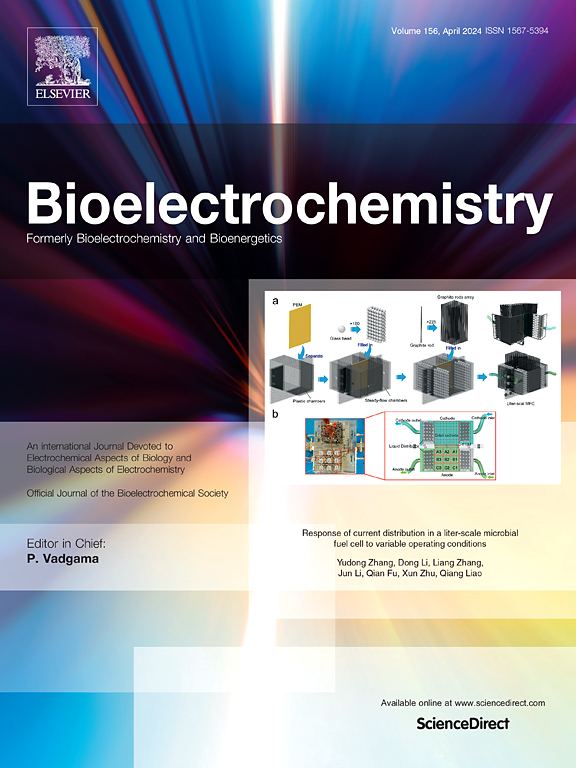用于酶基安培葡萄糖生物传感器柔性和稳定生物电催化传感层的高伸缩性、粘合性和导电性水凝胶。
IF 4.8
2区 化学
Q1 BIOCHEMISTRY & MOLECULAR BIOLOGY
引用次数: 0
摘要
合成了具有高伸展性、粘附性和导电性的三嵌段水凝胶,并将其用作基于酶的安培计葡萄糖生物传感器的柔性和稳定的生物电催化传感层。该水凝胶是通过 2-丙烯酰胺基-2-甲基-1-丙磺酸、甲基丙烯酰胺和甲基丙烯酸羟乙酯的一锅聚合制备的。利用 X 射线衍射、扫描电子显微镜、X 射线光电子能谱、傅立叶变换红外光谱和电化学技术对水凝胶的物理和化学特性进行了表征。将嵌入葡萄糖氧化酶(GOx)和壳聚糖(CTS)的水凝胶滴涂在玻璃碳电极(GCE)和丝网印刷石墨电极(SPGE)上。所制备的 GOx/CTS/hydrogel-GCE 和 GOx/CTS/hydrogel-SPGE 对葡萄糖的生物电催化氧化电流具有极佳的介导效果。GOx/CTS/hydrogel-GCE 的葡萄糖校准曲线显示,其线性范围为 0.25 至 15 mM,灵敏度为 27.0 µA mM-1 cm-2。这种涂覆在 SPGE 上的基于 GOx/CTS/ 水凝胶的传感层具有稳定的抗弯曲性,无论弯曲角度(0、30、60 和 90 度)如何,对葡萄糖的响应都几乎相同。此外,葡萄糖响应不受各种有机和无机干扰物的干扰,可以检测山羊血清中的葡萄糖。此外,GOx/CTS/水凝胶-GCE 在冰箱干燥状态下保存 30 天后,仍能保持 99.64% 的原始活性。本文章由计算机程序翻译,如有差异,请以英文原文为准。

Highly stretchable, adhesive and conductive hydrogel for flexible and stable bioelectrocatalytic sensing layer of enzyme-based amperometric glucose biosensor
Highly stretchable, adhesive and conductive triblock hydrogel was synthesized and utilized as a flexible and stable bioelectrocatalytic sensing layer of enzyme-based amperometric glucose biosensor. The hydrogel was prepared through one-pot polymerization of 2-acrylamido-2-methyl-1-propanesulfonic acid, methacrylamide, and hydroxyethyl methacrylate. The physical and chemical properties of the hydrogel were characterized with X-ray diffraction, scanning electron microscopy, X-ray photoelectron spectroscopy, Fourier transform infrared spectroscopy and electrochemical techniques. Glucose oxidase (GOx) and chitosan (CTS) embedded hydrogel was drop-coated on glassy carbon electrode (GCE) and screen printed graphite electrode (SPGE). The resulting GOx/CTS/hydrogel-GCE and GOx/CTS/hydrogel-SPGE exhibited excellent mediated bioelectrocatalytic oxidation current for glucose. The calibration curve of glucose by the GOx/CTS/hydrogel-GCE showed the linear range from 0.25 to 15 mM with the sensitivity of 27.0 µA mM−1 cm−2. This GOx/CTS/hydrogel-based sensing layer coated on the SPGE was stable against bending, and the response to glucose was almost same irrespective of the bending angles (0, 30, 60, and 90 degree). In addition, the response to glucose was not interfered by various organic and inorganic interfering species, allowed to detect glucose in goat serum. Furthermore, the GOx/CTS/hydrogel-GCE kept its original activity of 99.64 % during 30 days’ storage under dry state in refrigerator.
求助全文
通过发布文献求助,成功后即可免费获取论文全文。
去求助
来源期刊

Bioelectrochemistry
生物-电化学
CiteScore
9.10
自引率
6.00%
发文量
238
审稿时长
38 days
期刊介绍:
An International Journal Devoted to Electrochemical Aspects of Biology and Biological Aspects of Electrochemistry
Bioelectrochemistry is an international journal devoted to electrochemical principles in biology and biological aspects of electrochemistry. It publishes experimental and theoretical papers dealing with the electrochemical aspects of:
• Electrified interfaces (electric double layers, adsorption, electron transfer, protein electrochemistry, basic principles of biosensors, biosensor interfaces and bio-nanosensor design and construction.
• Electric and magnetic field effects (field-dependent processes, field interactions with molecules, intramolecular field effects, sensory systems for electric and magnetic fields, molecular and cellular mechanisms)
• Bioenergetics and signal transduction (energy conversion, photosynthetic and visual membranes)
• Biomembranes and model membranes (thermodynamics and mechanics, membrane transport, electroporation, fusion and insertion)
• Electrochemical applications in medicine and biotechnology (drug delivery and gene transfer to cells and tissues, iontophoresis, skin electroporation, injury and repair).
• Organization and use of arrays in-vitro and in-vivo, including as part of feedback control.
• Electrochemical interrogation of biofilms as generated by microorganisms and tissue reaction associated with medical implants.
 求助内容:
求助内容: 应助结果提醒方式:
应助结果提醒方式:


